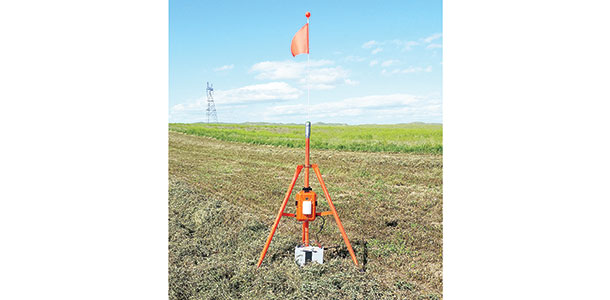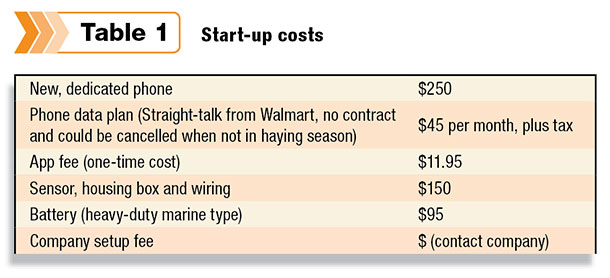It was like waiting for calving heifers, and neither Jim nor Connie got enough sleep during haying season. Connie says, “At our age, that was getting more difficult all the time. I could always hear his alarm going off; he could never quite hear mine.”

But Jim and Connie aren’t old. While custom haying on 800 acres and producing hay on 350 acres of their own, they were just tired of their process. Connie decided with all the new technology out there, there had to be a better way.
While Connie doesn’t consider herself “techy,” she did know how to run a smartphone. If she could use that phone somehow to help them get more sleep, she was willing to try it.
So Connie started poking around the Internet looking for an app that might help. She found an app built by a company (Valarm; www.valarm.net) with sensors for humidity detection, but they were being used for vineyards and strawberries in California.
Still, Connie thought their sensors might work on hay windrows, so she called them. When Connie explained what she wanted to do with the sensors, they agreed it should work in alfalfa as well as strawberries.

Then came the hard part – writing the checks. Sure, it wasn’t a $20,000 precision-farming outlay, but any time the checkbook is opened, it can be painful.
Connie bought a dedicated phone and had the new phone sent to Valarm, where they would make sure it was compatible with their system. They installed the phone into the box next to the sensor, got the wires running in the right direction and mailed it to the Umbles.
After watching some Valarm videos, Connie loaded the app onto the phone and walked through the setup to determine at what humidity level they wanted to receive a text message. She found it wasn’t any more complicated than running the TV remote control.
Jim took an old rooftop satellite-mounting tripod, affixed the box to it and hooked up the battery. Then he put it on the windrow in the lowest part of the field where humidity was first likely to reach the 45 to 48 percent mark they aimed for. (For good measure, he attached fluorescent flags so he wouldn’t run over it.)
And then – they went to sleep. No more two-hour checks, and then one-hour checks, and 15-minute checks as the humidity level they wanted grew near.
No more arguing about whose turn it was to get up. No more sending Jim out to bale at midnight all wired up with coffee and doughnuts – only to find the hay wasn’t ready, even though the house humidity indicator said it should be.
Sure enough, the text messaging worked. Whenever the humidity achieved the pre-set level, they received a message letting them know it was time to bale.
In fact, it worked so well, it almost worked too well. Jim and Connie would be entertaining friends for a barbecue and get a text message that it was time to bale hay. They’d be enjoying a tractor pull several miles from home and get a text message reminding them it was time to bale hay.
Connie adjusted the timings and settings a few times to customize the system to their operation, but it worked and they didn’t have to be “techy” to get started with ag technology. Jim says, “It has taken the pressure off determining when to bale.”
Jim and Connie shared their experience at the Mid-America Alfalfa Expo in December 2014, sponsored by the Nebraska Alfalfa Marketing Association.
After they shared their experience, several growers mobbed them, inspecting their equipment and wanting to know more. After all, it was simple and inexpensive, and what hay grower wouldn’t like to get a little more sleep? FG
PHOTO
A humidity sensor straddles a windrow in Wyoming and will send a text message to Connie and Jim Umble when the hay is ready to bale. Photo by Connie Umble.









